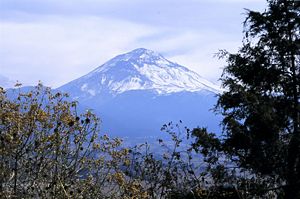Popocatépetl
| Popocatépetl | |
|---|---|
 Popocatépetl from Amecameca (looking south-east) |
|
| Elevation | 5,426 metres (17,802 ft) |
| Location | Mexico-Puebla-Morelos, Mexico |
| Prominence | 3,020 m |
| Type | Stratovolcano (active) |
| Volcanic arc/belt | Trans-Mexican Volcanic Belt |
| Last eruption | 2008 (ongoing) |
| First ascent | 1289 by Tecuanipas tribe |
| Easiest route | rock/snow climb |
| Listing | Ultra |
Popocatépetl (commonly referred to as Popo, El Popo or Don Goyo) (IPA: [popokaˈtepetɬ]) is an active volcano and, at 5,426 m., the second highest peak in Mexico after the Pico de Orizaba (5,636 m). Popocatépetl comes from the Nahuatl words popōca 'it smokes' and tepētl 'mountain', thus Smoking Mountain. Popocatépetl is linked to the Iztaccíhuatl volcano to the north by the high saddle known as the Paso de Cortés, and lies in the eastern half of the Trans-Mexican volcanic belt. It is named after the Aztec warrior Popocatépetl in the legend of Popocatépetl and Ixtaccihuatl.
Popocatepetl is one of the most active volcanoes in Mexico, having had more than 20 major eruptions since the arrival of the Spanish in 1519. Popo is currently active. A major eruption occurred in 1947 to begin this cycle of activity. Then, on December 21, 1994 the volcano spewed gas and ash which was carried as far as 25 km away by prevailing winds. The activity prompted the evacuation of nearby towns and scientists to begin monitoring for an eruption. In December 2000, tens of thousands of people were evacuated by the government based on the warnings of scientists. The volcano then made its largest display in thousands of years.


Popocatepetl is only 70 km to the southeast of Mexico City, from whence it can be seen regularly, depending on atmospheric conditions. The residents of Puebla, a mere 40 km east of the volcano, enjoy the views of the snowy and glacier-clad mountain almost all year long. The volcano is also one of the three tall peaks in Mexico to contain glaciers, with the others being Iztaccíhuatl and Pico de Orizaba. Magma erupted from Popocatépetl is a mixture of dacite (65 wt % SiO2, two-pyroxenes + plagioclase + Fe–Ti oxides + apatite, 3 wt % H2O, P = 1·5 kbar, fO2 = NNO + 0·5 log units) and basaltic andesite (53 wt % SiO2, olivine + two-pyroxenes, 3 wt % H2O, P = 1–4 kbar).
The first Spanish ascent of the volcano was made by an expedition led by Diego de Ordaz in 1519. The early 16th-Century monasteries on the slopes of the mountain are a World Heritage Site.
Contents |
The Legend of Popocatépetl and Iztaccíhuatl
In Aztec mythology, Ixtaccihuatl was a princess in an Aztec tribe. When she came of age, her father wanted her to marry an Aztec prince; however, she did not like any of them. One day by chance, she saw a prince named Popocatepetl in the street. He was the prince of an indigenous tribe in Mexico (the Chichimeca tribe), so when he wrote a letter asking the emperor if he could marry his daughter, the emperor was furious and would not allow it. Ixtaccihuatl insisted on the marriage, though, so the emperor agreed to it on one condition: Popo and his tribe must help the emperor's troops in a war against their enemy. The emperor intended on the prince dying in the war. [1]
Popo and the rest of the Chichimecas joined the Aztecs in war, but the Aztecs abandoned them at the height of the battle. Miraculously, the Chichimecas were still triumphant without the Aztecs' help. Even so, the emperor told his daughter that Popo had died in battle, and he wrote a letter to Popo saying that Ixtaccihutal had died of sadness in his absence. Popo did not believe the emperor, and sneaked into the palace to reunite with Ixtac. Together, they ran away to get married. When the emperor found out, he disowned his daughter and proclaimed she was dead to him.[2]
Ixtac and Popo built a humble house and lived happily for a few years. Suddenly, Ixtac got sick and died, in spite of Popo's efforts to save her. An earthquake occurred, and two volcanoes formed. A voice from the heavens ordered Popo to bring Ixtac's body to the peak of one of the volcanoes. He obeyed and placed Ixtac's body on top of a bed of flowers on the volcano. Popo then lay down next to her and waited to die. Years later, snow covered their dead bodies and they became two mountains. Popo became the mountain with smoke (known as montana humeante" or "smoking mountain", and Ixtac became the mountain without (known as "blanca estrella" or "white star"). The two mountains are named after the lovers to this day. [3]
Picture gallery
References
- Pittman, Richard S. (1954). A grammar of Tetelcingo (Morelos) Nahuatl. Language (journal of the LSA) 30.1 (Part 2). pp. 67 pp.
- Secor, R. J. (2001). Mexico's Volcanoes: A Climbing Guide (3rd ed.). Mountaineers Books. pp. 160 pp. ISBN 0-89886-798-3.
- Farza ue ca Korre, Esperanza (1971). Volcanes de México. Aguilar. pp. 237 pp. (in Spanish)
See also
- 4000 meter peaks of México
- 4000 meter peaks of North America
- List of volcanoes in Mexico
- Volcanic Seven Summits
- Mountain peaks of México
- Mountain peaks of North America
- The legend of Popocatépetl and Iztaccíhuatl
External links

- National Geographic News
- Popo-Cam: live picture, updated every two minutes
- Popo-Cam's best recent pictures
- Daily time-lapse animations of the Popo-Cam
- Did 750 AD Eruption of Popo Force Natives to Migrate to Southeastern U.S.A.?
- Popocatépetl Photos

|
|||||||